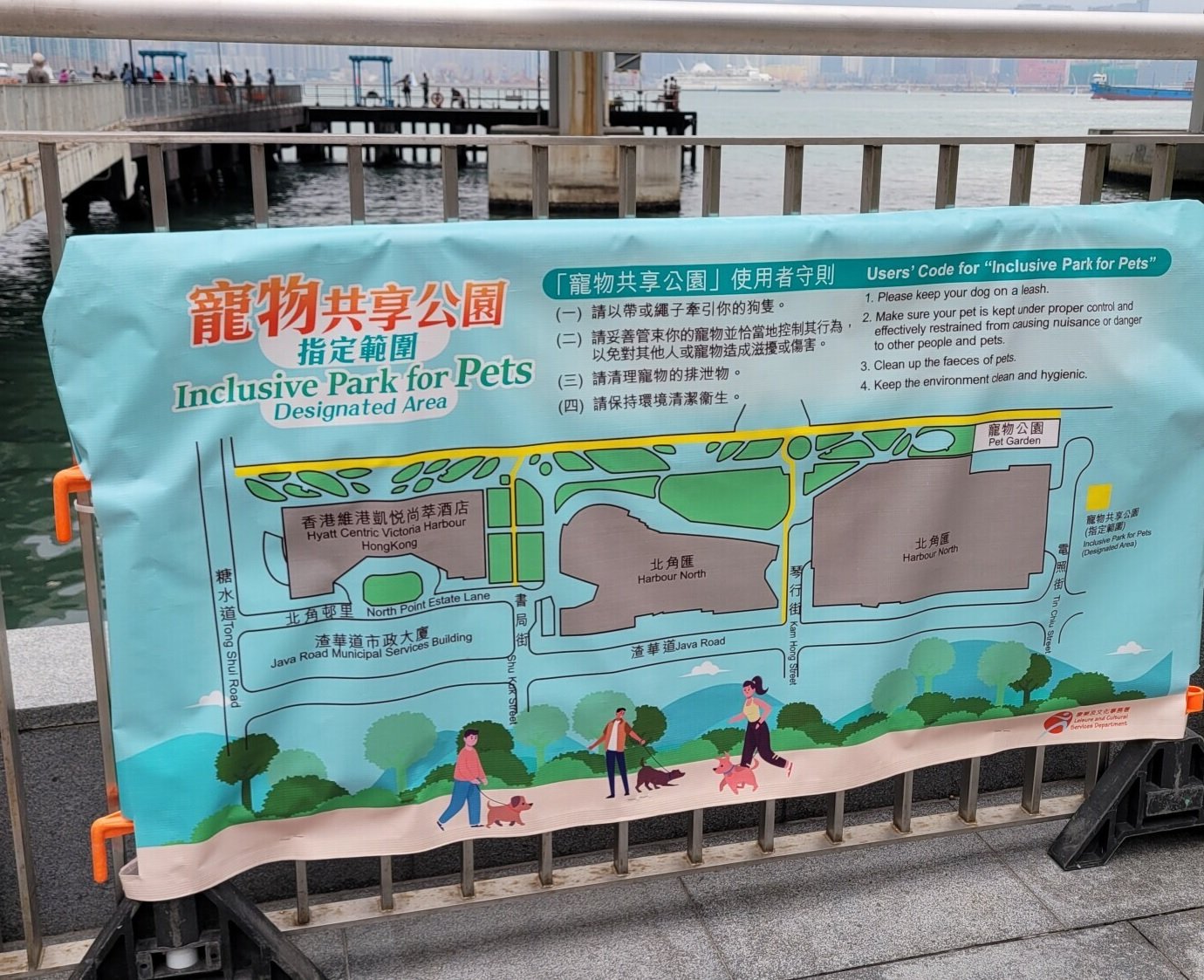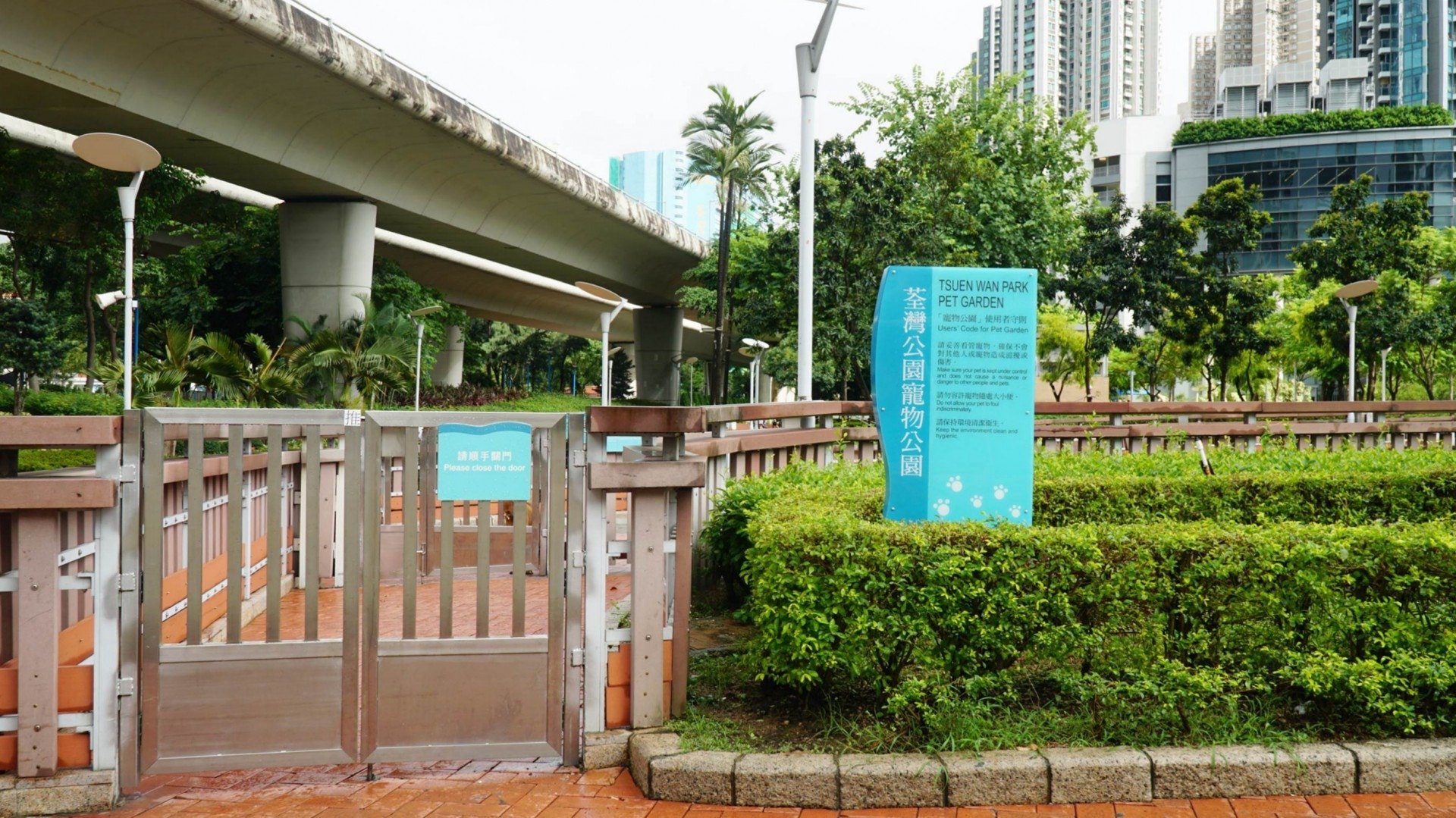寵物友善城市:以社區為單位 多方面建構寵物友善空間網絡|Pet-Friendly Cities: Building Comprehensive Pet-Friendly Networks at the Community Level







寵物友善城市:以社區為單位 多方面建構寵物友善空間網絡
在上一篇,吉人吉事檢視了香港目前在推行「寵物友善城市」的現況,發現到即使飼養寵物日漸普及,不同場地對寵物的接納程度仍相距甚遠,相關規範亦不盡相同,在生活上,不免為寵物主人們帶來困擾。這些規範和措施背後,或多或少都反映了不同持分者對寵物的觀點。正因如此,或能從目前的寵物相關措施中,梳理出推行「寵物友善城市」的阻力,甚至找出潛在解決方案。因此,吉人吉事團隊將從商場及公共空間出發,嘗試從這兩類現時有提供寵物相關服務和配套的場地,看看會否有「寵物友善程度」之異同,並歸納出目前瓶頸所在。文末亦會加入海外案例,參考不同城市在如何理解及促進人與寵物的共融,或能為香港提供新的切入點。
寵物友善措施推行多年 進度緩慢 癥結何在?
對不少市民而言,商場是集購物餐飲、消遣娛樂在一身的生活場所,尤其在炎炎夏日,比起露天公共空間,冷氣開放的商場更為吸引,亦更貼近平日出門的動線。對於不時要帶寵物出門「放電」的主人而言,若然在鄰近社區的公共空間之上再加上寵物友善商場,出門時便會多了選擇,造就更方便和舒適的體驗。然而,縱使近年不同場所陸續推出寵物友善措施,目前仍有不少可改善之處。
就商場和公園這兩類空間,吉人吉事認為目前的痛點在於:
商場:攜帶寵物進入之資訊透明度、寵物「不得落地行走」之規範。
公園:寵物相關配套不足、與臨近街道及地區割裂,不便進出。
全港50寵物友善商場 僅三成有公佈寵物守則 逾半禁止寵物落地行走
承接上一篇,吉人吉事進一步分析全港50個標榜或被評為寵物友善的商場,參照其官方網頁、社交媒體,以及各寵物相關資訊平台 [1] ,嘗試從它們的攜帶寵物進入商場指引、寵物友善服務和設施這三方面,檢視本港商場的「寵物友善程度」。團隊發現:
32% 有在其網頁或社交媒體公佈寵物進入商場指引,當中只有部分商場在其網頁上清晰列明寵物相關使用守則,其餘則在寵物相關活動推廣中略為提及。
56% 要求寵物必須以寵物車或袋,又或手抱才能進入場地。
44% 提供寵物友善設施及服務,例如提供免費寵物用品、借用寵物車和室外寵物友善區。除了寵物糞便收集箱等基本設施,部分更設立寵物專屬空間,例如「寵物樂園」、寵物共享天台花園、寵物遊樂設施等。但是,矛盾地,這些商場大多都禁止寵物落地行走,不禁令人思考,到底寵物友善場地的準則何在?
部分商場亦會:
禁止所有根據《危險狗隻規例》(第167D章)被歸類的「格鬥狗隻」及「已知危險狗隻」進入。
就不同身型之犬隻訂立附帶使用條件,例如要求身長於40厘米之犬隻必須戴上口罩及繫上牽繩。
要求寵物需接種疫苗方可進入。
限制每位主人可攜帶的寵物數量。
以上規範反映了場地營運者對於公共衛生、滋擾、安全及人流管理的考量。不止要顧及訪客的體驗及需求,還要考慮到個別商店之營運安排,尤其是受《食物業規例》(第132X章)第10B條規管 [2],不得容許狗隻進入食物業處所內的餐廳。撇除個別商場所提供的寵物相關設施和服務,綜合寵物相關資訊平台上的用家回饋,不少寵物友善場地「加分位」還包括:
交通便捷度
與鄰近寵物友善空間之距離及銜接,尤其位於寵物友善海濱場地附近之商場
商場內寵物友善商店或餐廳數量
寵物相關活動,例如寵物用品市集、領養日、特定主題「打卡位」
與寵物相關團體、資訊分享平台之合作,例如寵物用品優惠、寵物導賞團
寵物共享公園恆常化遇阻力 配套不足 近半設於場地指定位置
康樂及文化事務署(康文署)在2019年推出「寵物共享公園」 試驗計劃,其後在2021年陸續將寵物共享公園恆常化,至今已有175個寵物共享公園。雖然署方在計劃推行初期曾進行調查訪問,發現大多數使用者支持長遠推行計劃,但在落實時因為反對意見過多,而要擱置計劃的情況亦時有發生,可見市民對寵物的接受程度是推行寵物友善措施的阻礙之一。此外,不少寵物主人均反映寵物設施及配套不足。例如,不少公園在「轉型」後僅添置了狗糞收集箱、洗手設備等基本設施。事實上,全港只有20個寵物共享公園設有狗糞收集箱之外的寵物設施,包括寵物供水設施、狗廁所、狗隻活動區、飲水設施,平均每區只有大概一個,實不敷應用 [3]。再加上近半寵物共享公園設於場地的指定位置,即公園的其他位置仍禁止寵物進入,令寵物主人要特意繞道,從特定出入口或路徑進出公園,令整體使用體驗欠連貫性和自主度,未能貼合寵物主人實際使用需要 [4]。保持環境清潔、平衡不同使用者之需要固然重要,但就目前情況而言,比起共享公園,各種對於寵物及其主人的不便,更像是一道道將其拒諸門外的無形之牆。
連結不同場地 建構社區「寵物友善空間網絡」
然而,若是要更進一步提升香港的寵物友善程度,視野便不應停留於個別場地的配套和措施,又或是寵物友善場地的數量,而是要以社區為單位「做大個餅」,連結不同類型的寵物友善場所,同時加強這些空間與鄰近街道、周邊地區的銜接,提升整個社區的「寵物承載力」。目的不止在於增加寵物主人的出門選擇、締造更連貫和順暢的出門體驗,而是透過協調不同場地營運者,整合區內的寵物配套和設施,令其得以善用。以北角海濱花園一帶為例,該處有寵物友善商場和容許寵物搭乘的渡輪航線,其指定範圍亦理應是當區居民和寵物出門散步、便利市民經渡輪帶同寵物穿梭港九的好去處。但是,目前花園只有海濱長廊位置被劃為寵物共享公園,海旁及碼頭以外,花園與商場出入口相連的部分依然禁止寵物進出,硬生生地將數個歡迎寵物的地點分割開來,實屬可惜。類似情況在馬鞍山海濱長廊近沙田七十七區梯台亦曾發生,最終以增設「寵物通道」方式解決,可見已有先例可循。長遠而言,亦應將寵物友善概念納入整體規劃及發展策略中。正如愛護動物協會就2020施政報告公眾諮詢的公開信中提到,日後的規劃、設計,以至是實務執行,都應該涵蓋動物福利和寵物友善概念,尤其在收地重建、房屋發展、公共空間,以及可步行性等議題。
多倫多《寵物友善城市設計指南》:以整個社區為單位,三方面推動寵物友善
其中一個正嘗試從規劃層面推動寵物友善措施的城市便是多倫多。隨著人口及寵物數量與日俱增,現有的公共空間不敷應用,隨之而起的滋擾和衛生問題亦會容易引起摩擦。事實上,市內曾有大型屋苑因公用寵物空間不足而導致住戶間的衝突,最終不得不禁止住戶飼養新寵物以緩解爭執。事件引起了不少討論和關注,亦反映出在整體社區規劃和新住宅發展項目中,正視寵物作為城市空間使用者的迫切需要。此後,有發展商主動在其新住宅項目加入寵物設施,並以此為賣點。與此同時,當地市政府亦開始著手研究寵物友善城市設計及規劃,並在2019年推出了一份適用於多戶住宅大廈的新發展項目 (new multi-unit buildings)的《寵物友善城市設計指引》(Pet Friendly Design Guidelines and Best Practices for New Multi-unit Buildings)。指引以一個15分鐘步行距離內的社區為單位,從三方面——住宅單位 (unit)、屋苑或大廈 (building)、公共空間(park and open spaces) 詳列出不同場所應有的寵物友善配套及其設計標準,務求減少飼養寵物的障礙,同時促進寵物與人類和諧共處。而發展商在規劃初期,應以選址5至15分鐘步行範圍為基礎,審視社區中現有的寵物配套,以此為日後加入寵物友善設計、增設相關配套的根據。指引亦因應項目的規模,列明應有的公用寵物設施種類。例如,一個有100個或以上單位的項目,便要提供以下三類設施:戶外寵物廁所 (outdoor pet relief area)、戶外無牽繩活動區 (outdoor off-leash area) 及寵物沖洗區 (pet wash station)。
寵物友善成事在人 同理包容 走出對立
在香港,每當論及增設寵物相關設施、開放更多空間讓寵物使用,輿論往往會將矛頭指向寵物,將牠們和滋擾、衛生和安全問題劃上等號,部分人亦因此認為寵物的存在會直接侵害他們的空間體驗。但從近年的寵物友善措施,以至是多倫多的案例可見,與其將人和寵物放於對立面,一刀切地禁止寵物,或許問題關鍵更是在於「人」——各項寵物友善措施及配套最終成功與否,大程度上取決於寵物主人的公德心、場地營運者能否同理寵物主人的需要,以及市民大眾對寵物的接受程度。或許在規劃和設計之上,我們更需要包容和同理心,才能造就一個真正寵物友善的城市。
註:
[1] 各商場之寵物友善措施整合至以下來源:
- 各商場之官方網站及社交媒體
- PET-A-HOOD 寵物好去處(商場)
- 新傳媒 Sunday Kiss 2024寵物好去處|14個寵物友善商場+詳細規定
部分資料以英文撰寫,如有歧異,皆以原文英文版為準。
[2] 《食物業規例》(第132X章)第10B條訂明,任何人不得將狗隻帶進任何食物業處所內,以及任何從事食物業的人不得明知而容受或准許狗隻在任何食物業處所內出現。
[3] 20個設有狗糞收集箱之外的寵物設施之寵物共享公園為:
北區:百和路遊樂場 (指定位置)、聯和墟遊樂場 (近聯昌街) (指定位置)、天平路花園
離島:東涌北公園 (A2區) (指定位置)
荃灣:國瑞路公園 (指定位置)、荃灣海濱單車匯合中心 (指定位置)、深慈街遊樂場 (指定位置)
沙田:沙田公園 (指定位置)、馬鞍山海濱長廊 (指定位置)、石門遊樂場、城門河第三海濱花園
灣仔:維多利亞公園 - 山丘涼亭 (指定位置)
東區:鰂魚涌公園 (指定位置)
中西區:加多近街花園 (指定位置)、中西區海濱長廊——中環段 (指定位置)、山頂花園
深水埗:雀橋街休憩處
葵青:大窩口道遊樂場
黃大仙:永定道休憩處
元朗:宏業南街休憩花園
[4]截至2024年3月,康樂及文化事務署轄下共有175 個寵物共享公園,當中有78個設於場地指定位置,佔大約45%。
Pet-Friendly Cities: Building Comprehensive Pet-Friendly Networks at the Community Level
In the previous article, we examined Hong Kong's progress in becoming a "pet-friendly city." Despite increasing pet ownership, acceptance varies across venues, and inconsistent regulations create challenges for pet owners. These rules reflect diverse stakeholder perspectives on pets. By analysing current measures, we can identify obstacles and potential solutions. Hence, GUTS will explore shopping malls and public spaces to assess differences in their pet-friendliness and pinpoint bottlenecks. We will also include overseas cases to offer insights on fostering better integration of people and pets, which could provide new approaches for Hong Kong.
Slow Progress in Implementing Pet-Friendly Measures - What is the Crux of the Problem?
Shopping malls are popular spots for shopping, dining, and entertainment, especially during hot summer days due to their air conditioning, unlike openair public spaces. For pet owners who need to take their pets with them or walk their pets, having pet-friendly malls in addition to public spaces provides more options and a more convenient, comfortable experience. Despite recent efforts to introduce pet-friendly measures, there is still significant room for improvement.
Regarding shopping malls and parks, the GUTS team believes that the current pain points are:
Shopping malls: Transparency of information on bringing pets in, and the rule of prohibiting pets from walking on the premises’ floor.
Parks: Lack of pet-related facilities, and disconnection from the surrounding streets and neighbourhoods, making it inconvenient to enter and exit.
Only A Third of 50 Pet-Friendly Malls in Hong Kong Publicly Disclose Pet Policies, Over Half Ban Pets from Walking on the Premises’ Floor
Continuing from the previous article, the team analysed 50 shopping malls in Hong Kong labelled as pet-friendly. We examined their official websites, social media, and various pet-related platforms [1] to assess pet-friendliness in three areas: guidelines for bringing pets, pet-friendly services, and facilities.
32% of establishments have published pet entry guidelines on their websites or social media. Among these, only a few malls have clearly outlined pet-related usage rules on their websites, while the remainder have only briefly mentioned them when promoting pet-related activities.
56% mandate that pets must be transported in pet strollers or bags, or carried in the owner's arms to gain entry into the premises.
44% offer pet-friendly amenities and services such as complimentary pet supplies, stroller rentals, and outdoor pet-friendly areas. Some malls go beyond providing basic facilities like pet waste collection boxes and have dedicated pet spaces like "pet playgrounds," shared rooftop gardens for pets, and pet play areas. However, despite these amenities, most malls prohibit pets from walking on the premises’ floor, which makes one wonder: what truly defines a pet-friendly venue?
Some malls also:
Restrict entry for all "fighting dogs" and "known dangerous dogs" under the Dangerous Dogs Regulation (Cap. 167D).
Impose specific regulations based on dog sizes, including mandating muzzles and leashes for dogs over 40cm in length.
Mandate vaccination for all pets prior to entry.
Limit the number of pets each owner can bring.
The aforementioned rules mirror the venue operators' concerns regarding public health, nuisance, safety, and crowd control. These regulations must not only address visitors' experiences and requirements but also factor in the operational logistics of individual stores, particularly those regulated by Section 10B of the Food Business Regulation (Cap. 132X) [2], which bars dogs from entering food business establishments.
In addition to the pet-related facilities and services offered by individual shopping centres, user feedback on pet-related information platforms suggests that other "bonus points" for pet-friendly venues include:
Ease of access
Proximity to and integration with nearby pet-friendly areas, particularly malls situated near pet-welcoming waterfront
Presence of pet-friendly shops or eateries within the mall
Pet-oriented activities like pet product fairs, adoption events, and designated “photo spots”
Collaboration with pet-related groups and information-sharing platforms, such as pet product discounts and pet-guided tours
Obstacles in Regularising Inclusive Park for Pets, Lacking Facilities and Proper Integration
The Leisure and Cultural Services Department (LCSD) initiated an "Inclusive Park for Pets" pilot program in 2019, which was later formalised in 2021. As of now, there are a total of 175 inclusive parks for pets in operation. Although initial surveys conducted by the department showed strong support for the scheme's long-term implementation, some plans were shelved due to significant opposition. This suggests that public acceptance of pets remains a key obstacle to implementing pet-friendly measures.
Additionally, many pet owners have noted that pet facilities and amenities are insufficient. For instance, after the conversion, many parks have only added basic features like dog waste collection boxes and hand-washing stations. In fact, only 20 pet-friendly parks offer facilities beyond waste collection, such as pet watering stations, dog toilets, activity areas, and drinking fountains, averaging just one park per district, which is clearly inadequate [3]. Furthermore, nearly half of the pet-friendly parks restrict pets to designated areas, prohibiting them from accessing the rest of the park. This forces pet owners to use specific entrances or paths, leading to a disconnected user experience that lacks autonomy and doesn't fully meet their needs [4]. While it's important to maintain a clean environment and balance user needs, these restrictions can feel like invisible barriers excluding pets and their owners.
Connecting Different Venues to Build a Community "Pet-Friendly Space Network"
To enhance Hong Kong's pet-friendliness, the focus should extend beyond individual facilities and the number of pet-friendly venues. Instead, the community should join force by connecting various pet-friendly venues and strengthening their links with surrounding streets and neighborhoods. This approach aims to boost the community's overall "pet-capacity." The goal is to provide more options for pet owners, create a seamless outing experience, coordinate venue operators, and ensure effective use of pet facilities and amenities.
The North Point Promenade illustrates the potential for pet-friendly urban spaces, featuring malls and ferries that welcome pets. This area could serve as an ideal spot for residents and their pets to enjoy walks and conveniently travel across the harbour. However, only the promenade is currently designated as a pet-friendly zone. Areas along the waterfront, the pier, and those near mall entrances remain inaccessible to pets, creating a fragmented experience for pet owners. A similar issue arose at the Shatin Area 77 Landing of the Ma On Shan Promenade but was resolved by introducing a "pet passage."
In the long run, pet-friendly concepts should be integrated into urban planning and development strategies. As highlighted by the Hong Kong Society for the Prevention of Cruelty to Animals in their open letter during the 2020 policy address public consultation, future planning should incorporate animal welfare and pet-friendly designs. This includes considerations in land acquisition, redevelopment, housing projects, public spaces, and enhancing walkability.
Toronto's "Pet-Friendly City Design Guideline": Promoting Pet-Friendliness at the Community Level in Three Aspects
Toronto is actively promoting pet-friendly measures at the planning level. With a growing population and increasing pet ownership, existing public spaces have become inadequate, leading to conflicts over nuisances and hygiene issues. Some large housing estates have even banned new pets to reduce disputes, highlighting the need to recognise pets as urban space users in community planning and residential projects. This incident sparked significant discussion, prompting some developers to include pet facilities in new projects as selling points. Additionally, the local government began researching pet-friendly city design, and in 2019, released "Pet Friendly Design Guidelines and Best Practices for New Multi-unit Buildings" to guide new residential developments.
The guidelines focus on creating pet-friendly communities within a 15-minute walking distance, detailing design standards for residential units, buildings, and park and open spaces. The goal is to reduce barriers to pet ownership and promote harmonious coexistence between pets and humans. When planning a new project, developers should assess existing pet amenities within a 5-15 minute walking radius to incorporate pet-friendly designs and plan for future facilities. The guidelines also outline required communal pet facilities based on project size. For instance, projects with 100 or more units must include outdoor pet relief areas, off-leash zones, and pet wash stations.
Empathy and Inclusion: Moving Beyond Conflict in Pet-Friendly Communities
In Hong Kong, discussions about adding pet-related facilities often lead to concerns about nuisances, hygiene, and safety, with some fearing that pets might infringe on their space. However, recent measures and examples from cities like Toronto suggest a different approach. Instead of opposing pets, the focus should be on people. The success of pet-friendly amenities depends on the civic-mindedness of pet owners, the empathy of venue operators, and public acceptance of pets.
Perhaps beyond planning and design, tolerance and empathy are what we need to create a truly pet-friendly city.
Remarks:
[1] Pet-friendly measures in various malls are consolidated from the following sources:
Official websites of each mall
[2] Section 10B of the Food Business Regulation (Cap. 132X) states that no person shall bring any dog onto any food premises, and no person engaged in any food business shall knowingly suffer or permit the presence of any dog on any food premises.
[3] The 20 inclusive park for pets with pet facilities beyond dog waste collection boxes are:
North District: Pak Wo Road Playground (designated area), Luen Wo Hui Playground (near Luen Cheong Street) (designated area), Tin Ping Road Garden
Islands: Tung Chung North Park (A2 area) (designated area)
Tsuen wan: Kwok Shui Road Park (designated area), Tsuen Wan Waterfront Cycling Entry / Exit Hub (designated area), Sham Tsz Street Playground (designated area)
Sha Tin: Sha Tin Park (designated area), Ma On Shan Promenade (designated area), Shek Mun Playground, Shing Mun River Promenade Garden No. 3
Wan Chai: Victoria Park Hill Knoll Pavilion (designated area)
Eastern District: Quarry Bay Park (designated area)
Central and Western District: Cadogan Street Temporary Garden (designated area), Central and Western District Promenade - Central Section (designated area), Victoria Peak Garden
Sham Shui Po: Tseuk Kiu Street Sitting-out Area
Kwai Tsing: Tai Wo Hau Road Playground
Wong Tai Sin: Wing Ting Road Sitting-out Area
Yuen Long: Wang Yip Street South Rest Garden
[4] As of March 2024, LCSD has a total of 175 inclusive park for pets, of which 78 are located in designated areas, accounting for about 45% of total.
你可能對以下吉人吉事有興趣:
You may also be interested in these GUTS Stories:






